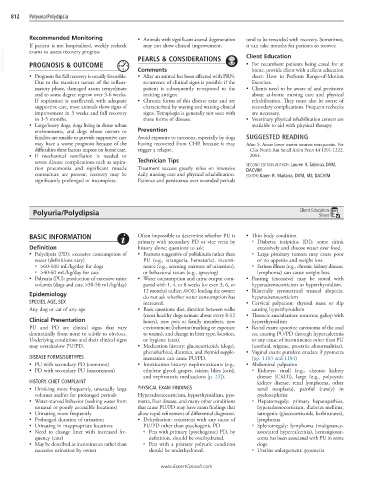Page 1611 - Cote clinical veterinary advisor dogs and cats 4th
P. 1611
812 Polyuria/Polydipsia
Recommended Monitoring • Animals with significant axonal degeneration tend to be rewarded with recovery. Sometimes,
If patient is not hospitalized, weekly recheck may not show clinical improvement. it can take months for patients to recover.
VetBooks.ir PROGNOSIS & OUTCOME PEARLS & CONSIDERATIONS Client Education
exams to assess recovery progress
• For recumbent patients being cared for at
• After an animal has been affected with PRN,
• Prognosis for full recovery is usually favorable. Comments home, provide client with a client education
sheet: How to Perform Range-of-Motion
Due to the transient nature of the inflam- recurrence of clinical signs is possible if the Exercises.
matory phase, damaged axons remyelinate patient is subsequently re-exposed to the • Clients need to be aware of and persistent
and to some degree regrow over 3-6 weeks. inciting antigen. about at-home nursing care and physical
If respiration is unaffected, with adequate • Chronic forms of this disease exist and are rehabilitation. They must also be aware of
supportive care, most animals show signs of characterized by waxing and waning clinical secondary complications. Frequent rechecks
improvement in 3 weeks and full recovery signs. Tetraplegia is generally not seen with are necessary.
in 3-5 months. these forms of disease. • Veterinary physical rehabilitation centers are
• Large/heavy dogs, dogs living in dense urban available to aid with physical therapy.
environments, and dogs whose owners or Prevention
families are unable to provide supportive care Avoid exposure to raccoons, especially by dogs SUGGESTED READING
may have a worse prognosis because of the having recovered from CHP, because it may Añor S. Acute lower motor neuron tetraparesis. Vet
difficulties these factors impose on home care. trigger a relapse. Clin North Am Small Anim Pract 44:1201-1222,
• If mechanical ventilation is needed or 2014.
severe disease complications such as aspira- Technician Tips SECOND EDITION AUTHOR: Lauren R. Talarico, DVM,
tion pneumonia and significant muscle Treatment success greatly relies on intensive DACVIM
contracture are present, recovery may be daily nursing care and physical rehabilitation. EDITOR: Karen R. Muñana, DVM, MS, DACVIM
significantly prolonged or incomplete. Patience and persistence over extended periods
Polyuria/Polydipsia Client Education
Sheet
BASIC INFORMATION Often impossible to determine whether PU is • Thin body condition
primary with secondary PD or vice versa by ○ Diabetes insipidus (DI): some drink
Definition history alone; questions to ask: excessively and choose water over food.
• Polydipsia (PD): excessive consumption of • Features suggestive of pollakiuria rather than ○ Large pituitary tumors may cause poor
water (definitions vary) PU (e.g., stranguria, hematuria), inconti- or no appetite and weight loss.
○ >60-100 mL/kg/day for dogs nence (e.g., seeming unaware of urination), ○ Serious illness (e.g., chronic kidney disease,
○ >40-60 mL/kg/day for cats or behavioral issues (e.g., spraying) lymphoma) can cause weight loss.
• Polyuria (PU): production of excessive urine • Water consumption and urine output com- • Panting (excessive) may be noted with
volumes (dogs and cats, >30-50 mL/kg/day) pared with 1, 4, or 8 weeks (or even 3, 6, or hyperadrenocorticism or hyperthyroidism.
12 months) earlier; AVOID leading the owner; • Bilaterally symmetrical truncal alopecia:
Epidemiology do not ask whether water consumption has hyperadrenocorticism
SPECIES, AGE, SEX increased. • Cervical palpation: thyroid mass or slip
Any dog or cat of any age • Basic questions: diet, duration between walks causing hyperthyroidism
(most healthy dogs urinate about every 8-12 • Thoracic auscultation: murmur, gallop with
Clinical Presentation hours), new pets or family members, new hyperthyroidism
PU and PD are clinical signs that vary environment (behavior/marking or exposure • Rectal exam: apocrine carcinoma of the anal
dramatically from none to subtle to obvious. to toxins), and change in litter type, location, sac causing PU/PD through hypercalcemia
Underlying conditions and their clinical signs or hygiene (cats). or any cause of incontinence other than PU
may overshadow PU/PD. • Medication history: glucocorticoids (dogs), (urethral, trigone, prostatic abnormalities).
phenobarbital, diuretics, and thyroid supple- • Vaginal exam: purulent exudate if pyometra
DISEASE FORMS/SUBTYPES mentation can cause PU/PD. (pp. 1183 and 1184)
• PU with secondary PD (common) • Intoxication history: nephrotoxicants (e.g., • Abdominal palpation
• PD with secondary PU (uncommon) ethylene glycol, grapes, raisins, lilies [cats], ○ Kidneys: small (e.g., chronic kidney
and nephrotoxic medications [p. 23]). disease [CKD]), large (e.g., polycystic
HISTORY, CHIEF COMPLAINT kidney disease, renal lymphoma, other
• Drinking more frequently, unusually large PHYSICAL EXAM FINDINGS renal neoplasia), painful (rarely) in
volumes and/or for prolonged periods Hyperadrenocorticism, hyperthyroidism, pyo- pyelonephritis
• Water-starved behavior (seeking water from metra, liver disease, and many other conditions ○ Hepatomegaly: primary hepatopathies,
unusual or poorly accessible locations) that cause PU/PD may have exam findings that hyperadrenocorticism, diabetes mellitus,
• Urinating more frequently allow rapid refinement of differential diagnoses. iatrogenic (glucocorticoids, barbiturates),
• Prolonged duration of urination • Dehydration: consistent with any cause of lymphoma
• Urinating in inappropriate locations PU/PD other than psychogenic PD ○ Splenomegaly: lymphoma (malignancy-
• Need to change litter with increased fre- ○ Pets with primary (psychogenic) PD, by associated hypercalcemia), hemangiosar-
quency (cats) definition, should be overhydrated. coma has been associated with PU in some
• May be described as incontinence rather than ○ Pets with a primary polyuric condition dogs.
excessive urination by owner should be underhydrated. ○ Uterine enlargement: pyometra
www.ExpertConsult.com

